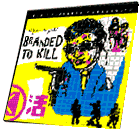

Japan action
1967
bw 91 min.
Director: Seijun Suzuki
CLV: $49.95 - available
1 disc, catalog # CC1513L
VHS: available from Home Vision Cinema
Untitled Document
Flipping around the channels of late-night TV in my Tokyo apartment in
1984 I came across what seemed like a B movie from the sixties. The studio:
Nikkatsu. The star: Shinishido Joe. The director: Suzuki Seijun. I was not
at all prepared for what I was about to see, and I remember spending much
of the following hour or so riveted to the screen with my mouth open. That
night changed my life and set me on a journey to explore the darker side
of a culture known predominantly for its classical beauty.
What I discovered were entire genres of popular films that had never
been seen outside of Japan. Harb-Boiled noir, Nikkatsu Action, Toei Pink,
Roman Porno. Far from the highly respected award-winning films on the international
film circuit, these were the popular low-budget B pictures that the public
thrived on. This, then, was the world of gossip columns, fan magazines,
and superstars who graced the walls of Yakitori shops, nomiya (bars),
and family-run businesses. This was the life and blood of Japan, neatly
hidden from foreign eyes who, it was assumed, would not understand what
the attraction was in the first place.
In the post-war fifties and sixties, Japan had its own version of the
Hollywood star and the studio system. Names like Watari Tetsuya, Kitahara
Mie, and Kobayashi Akira may be largely unheard of in the west, but in Japan
they are as famous as Bogart, Monroe, and Brando. Countless directors flourished
in the studios of Daiei, Toei, and Nikkatsu as directors for hire -- auteurs
in their own right. By comparisson, Kurosawa's work is considered more "Western."
Here we are looking at a whole new aesthetic, where plot and narrative devices
take a back seat to mood, music, and the sensuality of visual images. Character
development is often distilled into moments. There is a quality of timelessness
-- The Floating World translated to the scope screen.
Of all the B studio directors, the one who perhaps most deservedly has
earned the title auteur is Suzuki Seijun. Of the forty-two films Suzuki
made for Nikkatsu, the final fourteen films he made between 1963 and 1967
are some of the most important, original, and Japanese films of all
cinema, and of all his disturbing masterpieces, none is as powerful or unique
as Branded to Kill. Each time I see it I discover something new --
it's like seeing it for the first time.
Astonishing. Exhilarating. Inspiring.
Nobody utilized Cinemascope like the Japanese (its similarity in shape
to the Kabuli stage is suggested as a possible reason) and the use of the
scope screen reached extravagantly delirious heights in the hands of master
cinematographers like Mine Shigeyoshi and Nagatsuka Kazue, and directors
like Suzuki Seijun. In Branded to Kill and Tokyo Drifter (Tokyo
Nagaremono), each shot is a masterpiece of Japanese design. These traditions
go back centuries, but on the scope screen they hit us afresh and right
where we live.
Born in 1923 during the short-lived and quirky Taisho period in Japan,
Suzuki inherited a powerful appetite for Haikara (modern style) that
was tempered by his experiences in World War II. As the member of a meteorological
unit, he was twice shipwrecked in the Philippines and Taiwan, and bore witness
to atrocities we can only imagine. His nihilistic philosophy is quite apparent
in his work -- "Making things is not what counts: the power that destroys
them is" -- as a kind of playful irreverence that echoes the French
New Wave that influences Suzuki and his contemporaries.
Suzuki Seijun's Branded to Kill is a cinematic masterpiece that transcends
its genre. It is about as close to traditional Yakuza pictures as Godard's
Alphaville is to science-fiction. Suzuki paid a price for his brilliance,
however. Fired for "incomprehensibility" after making Branded
to Kill, he was unable to work in film for ten years. This film is his seminal
work; a genre film from a major Japanese studio by a team of creative geniuses
who made no compromises. But here the genre is merely a point of departure.
Destination: Out.
John Zorn
John Zorn is a New York-born composer who has been living off and on
in Tokyo since 1984.
CAST
Hanada Goro ... Shishido Joe
Hanada Mami ... Ogawa Mariko
Nakajo Misako ... Mari Annu
Number One Killer ... Nanbara Koji
CREDITS
Director ... Suzuki Seijun
Producer ... Iwai Kaneo
Camera ... Nagatsuka Kazue
Script ... Guryu Hachiro
Music ... Yamamoto Naozumi
Design ... Kawahara Naozumis
Editor ... Tanji Mutsuo
Assistant Director ... Kuzuu Masami
ABOUT THE TRANSFER
Criterion presents the American premiere of Branded to Kill in
a pristine transfer from the original Nikkatsu-scope master.




